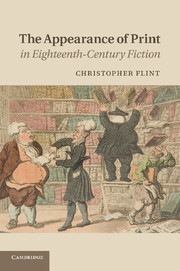Description
The Appearance of Print in Eighteenth-Century Fiction
Author: Flint Christopher
Explains how new print technologies and the expansion of print culture allowed eighteenth-century writers to develop the novel form.
Language: EnglishApproximative price 48.38 €
In Print (Delivery period: 14 days).
Add to cart
The Appearance of Print in Eighteenth-Century Fiction
Publication date: 07-2014
Support: Print on demand
Publication date: 07-2014
Support: Print on demand
Approximative price 99.37 €
In Print (Delivery period: 14 days).
Add to cart
The appearance of print in eighteenth-century fiction
Publication date: 09-2011
296 p. · 15.2x22.9 cm · Hardback
Publication date: 09-2011
296 p. · 15.2x22.9 cm · Hardback
Description
/li>Contents
/li>Biography
/li>
Eighteenth-century fiction holds an unusual place in the history of modern print culture. The novel gained prominence largely because of advances in publishing, but, as a popular genre, it also helped shape those very developments. Authors in the period manipulated the appearance of the page and print technology more deliberately than has been supposed, prompting new forms of reception among readers. Christopher Flint's book explores works by both obscure 'scribblers' and canonical figures, such as Swift, Haywood, Defoe, Richardson, Sterne and Austen, that interrogated the complex interactions between the book's material aspects and its producers and consumers. Flint links historical shifts in how authors addressed their profession to how books were manufactured and how readers consumed texts. He argues that writers exploited typographic media to augment other crucial developments in prose fiction, from formal realism and free indirect discourse to accounts of how 'the novel' defined itself as a genre.
Part I. Author, Book, Reader: 1. Preface: prose fiction and print culture in eighteenth-century Britain; 2. Pre-scripts: the contexts of literary production; 3. Post scripts: the fate of the page in Charles Gildon's epistolary fiction; Part II. Reader, Book, Author: 4. In other words: printers' ornaments and the substitutions of text; 5. Inanimate fiction: circulating stories in object narratives; 6. Only a female pen: women writers and fictions of the page; 7. After words; Notes; Bibliography; Index.
Christopher Flint is Associate Professor of English at Case Western Reserve University, Ohio.
© 2024 LAVOISIER S.A.S.





